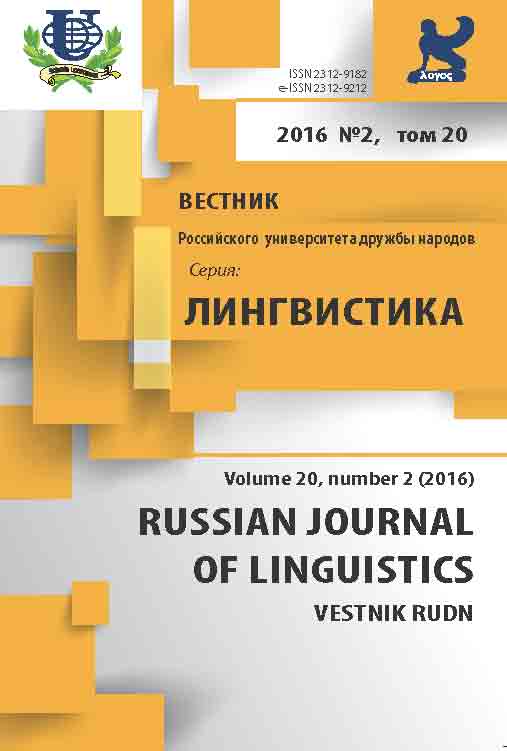Усечения в корейском интернет-языке
- Авторы: Егорова К.Г.1, Ан Сан Чоль -1
-
Учреждения:
- Северо-Восточный федеральный университет им. М.К. Аммосова
- Выпуск: Том 20, № 2 (2016)
- Страницы: 100-111
- Раздел: Статьи
- URL: https://journals.rudn.ru/linguistics/article/view/14709
Цитировать
Полный текст
Аннотация
Целью работы является установление закономерностей усечения в интернет-коммуникации и факторов, инициирующих усечение на основе теории оптимальности, предложенной Маккарти и Принц 1995, Маккарти 2008. Задачами являются рассмотрение типов усечений в корейском языке, детальный анализ общих процессов усечения на основе аналитического инструмента - теории оптимальности. Усеченные формы в корейском языке встречаются в основном в интернет-общении, а не в обычной коммуникации. Существует три основных типа усечения в интернет-общении. В качестве инструмента анализа в работе мы используем основную структуру теории оптимальности. В ходе исследования, мы привлечем некоторые главные ограничения, и покажем, каким образом, они взаимодействуют, чтобы представить реализацию поверхности этих новых форм. Прежде всего, два основных ограничения: слабое усечение (далее - TRUNCATE-Weak) и восстанавливаемость (далее - Recoverability) показывают, что морфонологические слабые элементы подвергаются усечению, только если первоначальная форма или смысл могут быть восстановлены из усеченных единиц. Кроме того маркированные ограничения: *глайдовая рекурсия (Off-glide), *СС, *VV, *VhV взаимодействуют с верными ограничениями, такими как MAX-начальный (далее Max-Initial) и MAX-s, в которых маркированные ограничения занимают место выше, чем верные ограничения. Несмотря на ограничение, вызванное усечением в интернет-общении, усечение не будет применяться, если первоначальная форма (значение) не может быть восстановлена из усеченных. В любых морфонологических изменениях основным ограничением является ограничение - Recoverability. В статье показано также то, что такой же аналитический метод применяется в усечении английских заимствований.
Ключевые слова
Об авторах
Кюннэй Григорьевна Егорова
Северо-Восточный федеральный университет им. М.К. Аммосова
Email: kiounnei1@yandex.ru
Институт зарубежной филологии и регионоведения ул. Белинского, 58, Якутск, Россия, 677000
- Ан Сан Чоль
Северо-Восточный федеральный университет им. М.К. Аммосова
Email: cahn.mail@gmail.com
Институт зарубежной филологии и регионоведения ул. Белинского, 58, Якутск, Россия, 677000
Список литературы
- Ahn Sang-Cheol. 2010. Korean Phonology. London: EAP.
- Beckman Jill N. 1997. Positional Faithfulness. Doctoral dissertation, University of Massachusetts.
- Crystal David. 2001. Language and the Internet. Cambridge University Press.
- Crystal David. 2008. Txtng: The Gr8 Db8. Oxford University Press.
- Crystal David. 2010. Internet Linguistics. London: Routledge.
- Jeon Byung-yong. 2002. 통신언어의 음운론적 특성에 대한 연구-대화방 언어를 중심으로. Hanguk Eoneo Munhwa (Korean Language and Culture) 21:251-274, 한국언어문화학회. Hanguk Eoneo Munhwa Hakhoe.
- Kager René. 1999. Optimality Theory. Cambridge University Press.
- Lee Jeong-bok. 2003. 인터넷 통신언어의 이해 (Understanding Internet Languages). Wolin.
- Lee Jeong-bok. 2005. 사회언어학으로 인터넷 통신언어 분석하기 (Analyzing Internet languages in sociolinguistcs). Hangukeohak (Korean Linguistics) 27, 37-79. Hangukeo Hakheo.
- Lee Jeong-bok. 2009. 인터넷 통신언어의 확장과 한국어 연구의 확대 (Expansion of Internet-mediated languages and Korean language studies). Sothong.
- Lee, Jeong-bok. 2012. 스마트폰 시대의 통신 언어 특징과 연구 과제 (Usages, research trends, and challenges of net-language in the smart-phone era). The Sociolinguistic Journal of Korea 20: 1, 177-211.
- Lee Ju-Hee. 2010. Tongsin eoneouy phyogiwa eumunjeok theukseong (A Study of Phonological features and orthography in computer mediated language). Linguistic Research 27.1: 1-18.
- Lee Ju-Hee and Sunwoo Park. 2012. 한국어 문자메시지의 표기와 특성: 20대 대학생을 중심으로 (A study of writing styles and characteristics of Korean text messages: With reference to university students). Studies in Phonetics, Phonology and Morphology 18:1, 131-161.
- McCarthy John and Alan Prince. 1995. Faithfulness and reduplicative identity. University of Massachusetts Occasional Papers 18: Papers in Optimality Theory, 249-384.
- McCarthy John. 2008. Doing Optimality Theory. Malden, MA: Blackwell.
- Oh, Mira. 2003. A correspondence-theoretic account of truncation. Korean Journal of Linguistics 28. 4, 629-650.
- Park Cheol-Ju. 2006. PC 통신언어 명사의 음운론적 연구. Gukeo Gyoyuk (Korean Language Education) 119: 457-486, 한국어교육학회 (The Society of Korean Language Education).
- Partridge Eric. 1942. Dictionary of Abbreviations. London: George Allen and Unwin.
- Shi Chung-Kon. 2006. 사이버 언어의 조어법 연구 (A study on word-formation patterns in cyber language). Hangukeohak (Korean Linguistics) 31: 215-243, Hangukeo Hakheo.
- Song Min-Kyu. 2004. 사이버언어 사전과 사이버언어의 현재 (A dictionary of cyberlanguage and a present condition of cyberlanguage). Hangukhak Yeongu (Korean Studies) 20: 107-126. Center for Korean Studies, Korea University.
- Song, Min-Kyu. 2007. 가상공간의 신어연구 (A Study on the New Words in Cyber-space). Doctoral dissertation, Korea University.

















